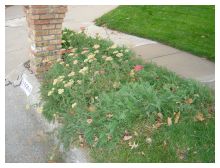Water-saving Turfgrasses

People always ask us, "What kind of grass should I plant in my yard?" In addition to knowing what kind of grass or which grass species, you also need to know which cultivars are best. Some are better than others in terms of drought tolerance, disease resistance, color, growth habit, etc.
The best place for this information is the National Turfgrass Evaluation Program. This is an independent nationwide testing and turfgrass evaluation organization that provides reliable recommendations for specific locations in the United States. If you live in Nebraska, click on the test locations identified as NE. The key to using the site is to compare the contents of the products available in garden centers and hardware stores to the data presented on the site.
Most grass seed packages contain a mix of species and cultivars. Make a list of specific cultivars offered, and compare them to the data presented on the site. If the cultivar listed on the package is not listed on the site, it doesn't mean that the product or cultivar is bad, just that we don't have any independent, research-based information about them.
A "cultivar" is a combination term for "cultivated variety." A "variety" is a naturally occurring deviation from the species. A cultivar is a man-made cross, usually the result of crossing one variety with another to produce
Water-saving Ornamentals

Gardeners use about twice as much water in their landscapes as is needed. In most gardens, the amount of water used can be reduced without creating serious plant problems.
Homeowners have two options in developing a water-efficient garden and landscape:
- Plan an entirely new landscape; or
- Develop greater water efficiency in the existing landscape.
On large sites, both approaches may be possible as new sections are developed while older areas are remodeled. In planning new sites or adding new plants to existing sites, whenever possible you should choose plants for most of your landscape that can survive short periods of heat and drought. A good way to determine which plants can endure in the garden or landscape without extra water is to observe native plants.
The better and deeper the soil preparation and improvement, the greater will be the plant's ability to survive.